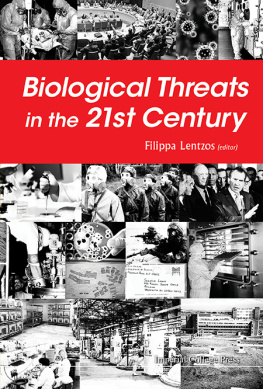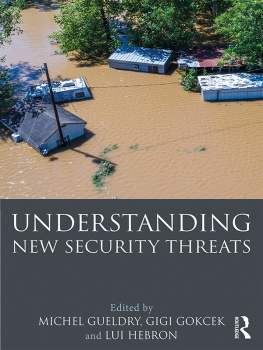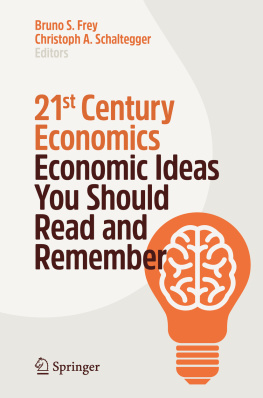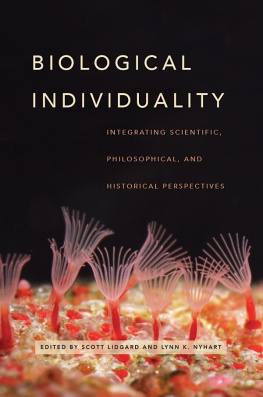Published by
Imperial College Press
57 Shelton Street
Covent Garden
London WC2H 9HE
Distributed by
World Scientific Publishing Co. Pte. Ltd.
5 Toh Tuck Link, Singapore 596224
USA office: 27 Warren Street, Suite 401-402, Hackensack, NJ 07601
UK office: 57 Shelton Street, Covent Garden, London WC2H 9HE
Library of Congress Cataloging-in-Publication Data
Names: Lentzos, Filippa.
Title: Biological threats in the 21st century / Filippa Lentzos.
Description: New Jersey : Imperial College Press, [2016]
Identifiers: LCCN 2015050736 | ISBN 9781783269471 (hc : alk. paper)
Subjects: LCSH: Biological warfare. | Biological warfare--Prevention. |
Biological weapons. | Bioterrorism--Prevention.
Classification: LCC UG447.8 .L46 2016 | DDC 358/.38--dc23
LC record available at http://lccn.loc.gov/2015050736
British Library Cataloguing-in-Publication Data
A catalogue record for this book is available from the British Library.
Copyright 2016 by Imperial College Press
All rights reserved. This book, or parts thereof, may not be reproduced in any form or by any means, electronic or mechanical, including photocopying, recording or any information storage and retrieval system now known or to be invented, without written permission from the Publisher .
For photocopying of material in this volume, please pay a copying fee through the Copyright Clearance Center, Inc., 222 Rosewood Drive, Danvers, MA 01923, USA. In this case permission to photocopy is not required from the publisher.
Desk Editors: Chandrima Maitra/Mary Simpson
Typeset by Stallion Press
Email:
Printed in Singapore
Preface
An excerpt from my fieldnotes reads:
The men and women who built the United Nations understood that peace is more than just the absence of war. A lasting peace, for nations and for individuals, depends on a sense of justice and opportunity, of dignity and freedom. It depends on struggle and sacrifice, on compromise, and on a sense of common humanity .
It is a quote from President Barack Obamas first address to United Nations (UN) member states in 2011. His message, in plain English, was that peace is hard.
It was a moving speech, and my notes of it are riddled with checks, underlined words and exclamation marks. Obama brought the national representatives, sitting behind their country name plates in the General Assembly Hall on East 42nd Street, back to first principles, to the intention of the founders of the United Nations, in the wake of the horror and staggering scale of death in the world wars, to make not merely peace, but a peace that will last.
Obamas words on the pursuit of peace in an imperfect world resonated with words I was reading in a very different aspect of my life. Earlier in 2011, I had given birth to my second daughter and I had become very interested in childrens learning and development.
The pursuit of peace, I found, was also something that occupied one of the great leaders in this field. Maria Montessori, whose writings and lectures in the first half of the 20th century increasingly linked societal problems with inappropriate educational systems, and who was nominated for the Nobel Peace Prize for furthering international understanding through her educational work, wrote:
Establishing lasting peace is the work of education; all politics can do is keep us out of war .
(Montessori, 1992: viii)
Like her contemporaries who founded the United Nations, Maria Montessori believed peace was more than just avoiding war. For her, peace was primarily about restructuring society through education. She worked with very young children to develop a pedagogy for peace that teaches values such as global citizenship, personal responsibility and respect for diversity on an equal footing with maths, language and science. It is by fostering these values, alongside the intellectual skills of critical thinking, analysis and problem-solving, that we nurture a culture of peace and non-violence.
The driving force behind this book has been a desire to develop the next generations understanding of the social contexts of biological threats and our responses to them, and, through this, to strengthen its resolve that biological weapons are not developed or used. By critically engaging with the personal, political and historical dimensions of biological weapons, the book highlights how these weapons are not merely the products of particular historical intersections and of technological, political and cultural conjunctures, but also of individual choices and values. The message is that individuals and their moral frameworks matter, not just in the conception, development and use of biological weapons, but in efforts to create a lasting ban and to sustain the moral abhorrence against these weapons.
My own journey into the biological weapons world began when I was still an undergraduate student at University College London. It was inspired by Brian Balmer, my personal tutor at the time, and his wonderful course Science, Warfare & Peace. Brian has continued as a mentor to me over the last 20 years and has grown to become a dear colleague. My initial engagement with the Biological Weapons Convention (BWC) and the disarmament diplomacy community was encouraged by Nicholas Sims during my time at the London School of Economics & Political Science. A decade has already passed since we first sat down in the Senior Dining Room to discuss how we could best support the treaty and to draft the first of what has become an extensive series of joint statements to BWC meetings. I treasure his mentorship. My sincere thanks to both Nicholas and Brian for their guidance and continual encouragement over the years.
Also formative in my early years were Jeanne Guillemin, Julian Perry Robinson, Matt Meselson, Malcolm Dando, Alastair Hay and Graham Pearson who all deserve a special mention for their inspiration and support.
This book has been a collective effort, and my deep appreciation goes first and foremost to the set of outstanding contributors who have generously shared their research, perspectives and experiences through the chapters and point of views. It is their contributions that make this book, and it has been a real pleasure to work with each and every one of them.
I am also grateful to Amy Smithson for her encouragement and substantive contributions at the inception of this project. I fondly remember long late night phone calls across the Atlantic and a walk on the Wilton Park grounds as we thought about different approaches to tell the story of biological weapons and who the right people were to tell those stories. Amy suggested combining some chapters, adding new topics and shorter companion pieces for certain chapters to highlight events or factors of particular note, and the concluding roundtable to expose the breadth of opinion on issues in the field. Amy was also instrumental in getting some of the contributors on board.
A warm thank you to Andy Weber and Ray Zilinskas for use of their photographs of the Soviet BW program and to artist Kathryn Smith for use of her photographs of the South African BW program on the front cover.









